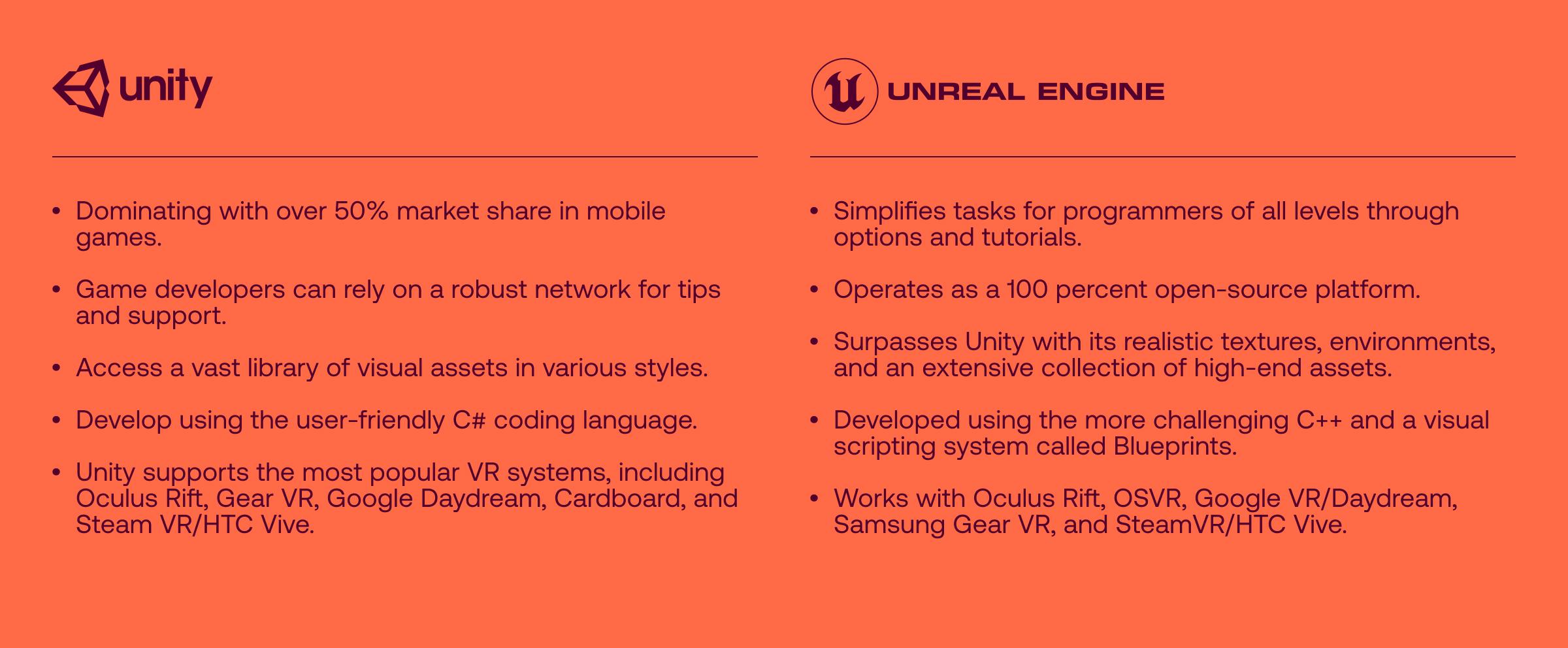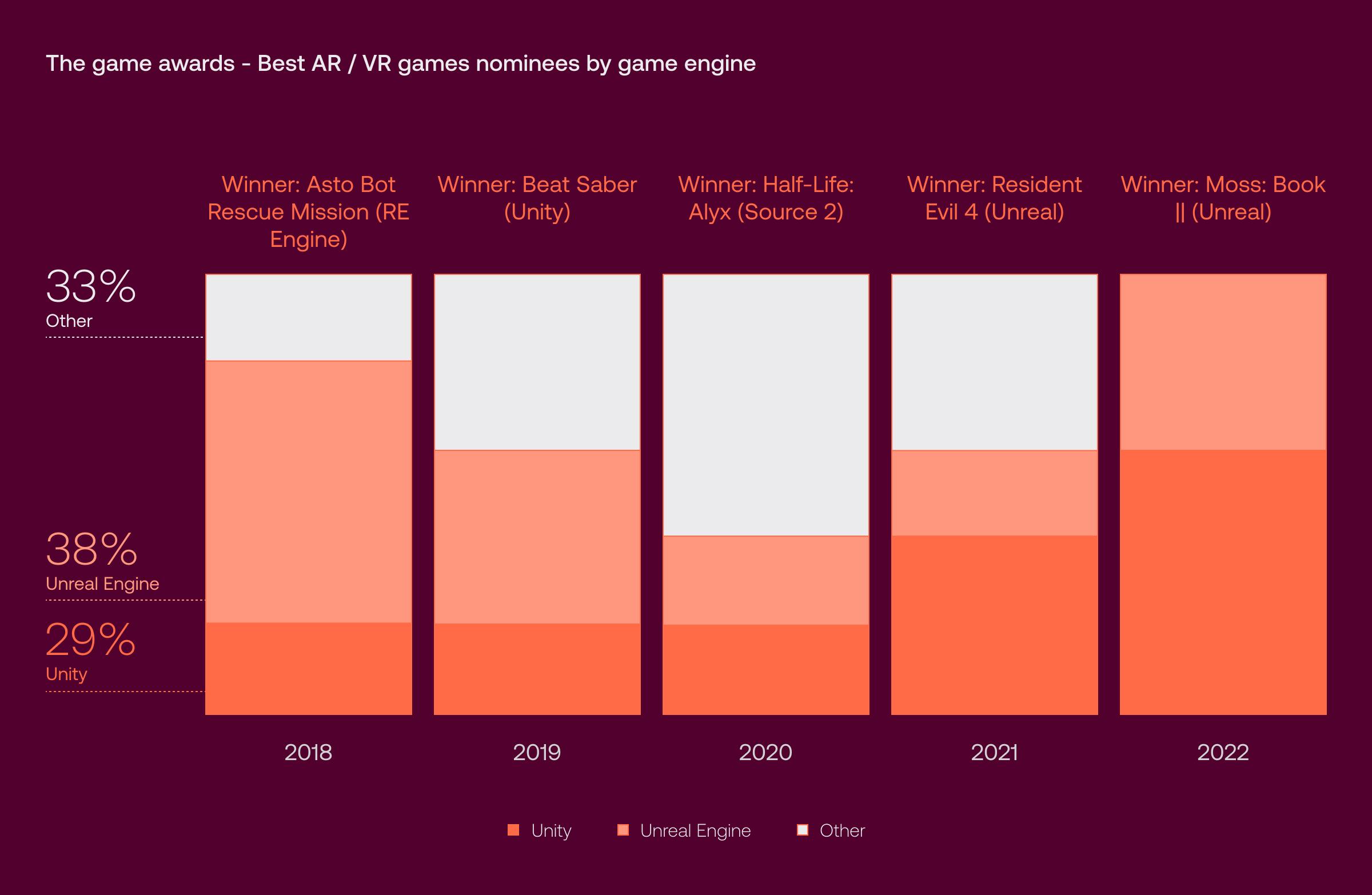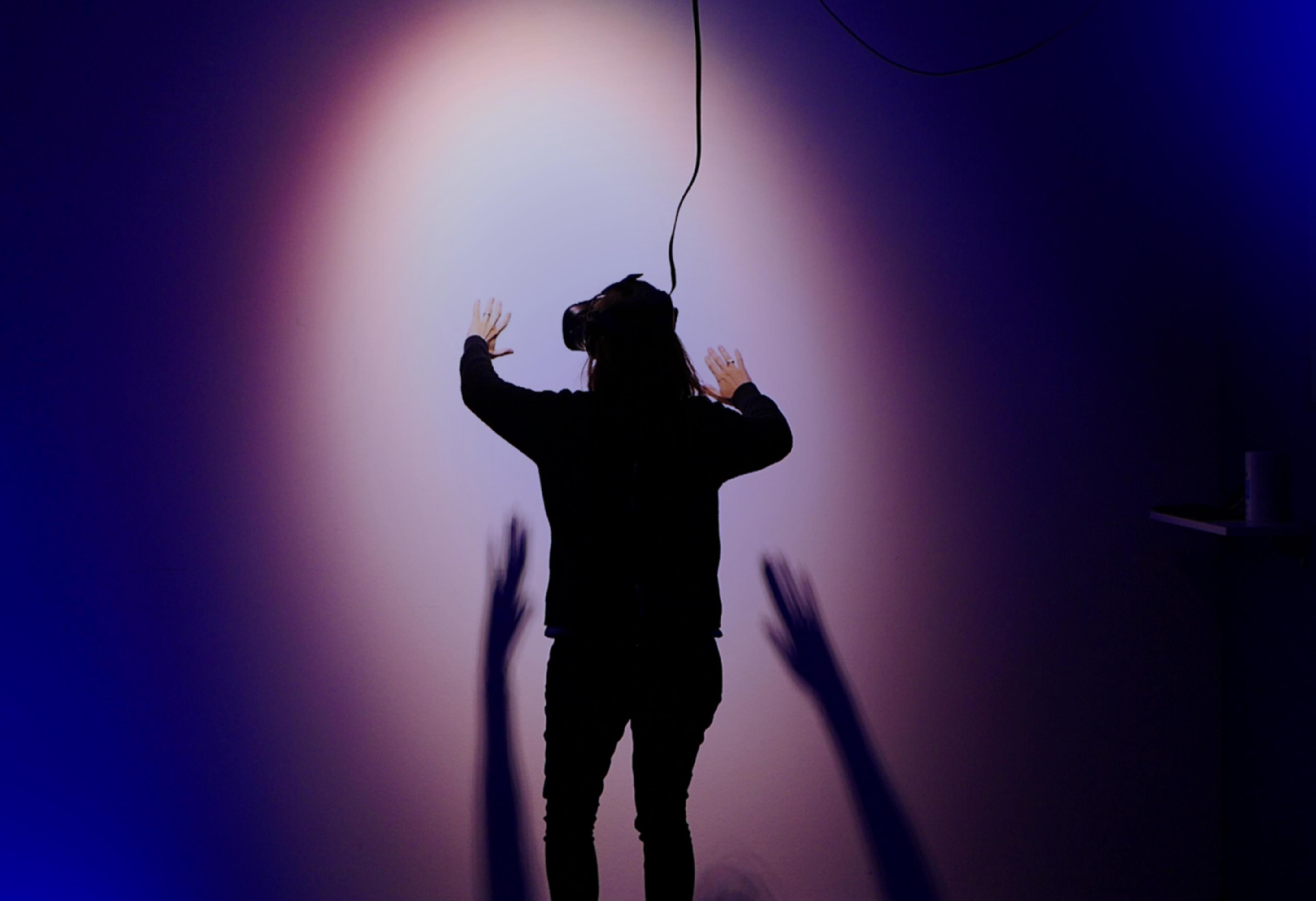
How to choose an engine for VR: Unity vs Unreal

Whether you’re working on a revolutionary VR first-person shooter or fine-tuning the user experience on high-end apartment tours, VR is at its best when users feel part of the world they see. VR developers know that full-well — it’s at the heart of their profession, after all — and there’s no shortage of VR engines on the market that deliver high-quality, immersive 3D graphics that put users and players into VR’s unique flow states.
Not all VR engines, however, are also easy to develop for or support multiple platforms from the get-go. These, alongside other considerations, often narrow the “which engine should I use in VR” decision down to two major players: Unity and Unreal.
Unity is bigger in a lot of ways — more market share, a larger asset library, and more devs to pick from. Unreal, on the other hand, is renowned for the unparalleled quality of its 3D assets and open-source nature. So, right out of the gate, there isn’t an objectively better choice.
There is, however, likely a better choice for your particular project once you sit down and compare the two.

Top-level differences
A look at any “Top 10 VR Games by Revenue” list might reveal a strong VR bias towards Unity. Unity games, after all, always command over 50 percent of the charts, while Pavlov VR is the only Unreal game consistently on Top 10 lists by either downloads or revenue.
But those charts are a trap for a multitude of reasons. Many popular VR titles like Superhot are ports from their original, non-VR counterparts, and weren’t made with VR in mind, so their VR popularity comes from a preexisting fanbase. Moreover, the revenue of VR games — still niche when compared to console or mobile games — pales in comparison to standard titles, so if your project’s goal is driven entirely by revenue, chances are that pure VR isn’t the most optimal medium for it.
Perhaps most importantly, virtual reality development goes beyond gaming. We tend to conflate the two because both demand interactivity, but virtual and mixed reality apps can facilitate user interaction in many non-gaming ways — in high-tech museum and virtual tours through ancient Greek temples, educational courses in biology and alpinism, surgery training simulations, and even roller coaster rides. Gaming might still be the primary use case for Unity and Unreal, but the cross-industry applications of both limit the utility of comparing them simply on their gaming merits.
The skinny on Unity for VR
The Unity engine is a proven platform and the go-to for many VR creators and game development experts, especially when it comes to mobile games, where it boasts over 50 percent of market share. Its longstanding popularity means there’s a huge game developer network to rely on for tips and support whenever you need help, as well as many internet tutorials and examples to draw from.
Unity also has a huge library of visual assets — tens of thousands of objects, models, and environments to choose from, in many different styles. Old Western saloon? Sure. Japanese shrines? Yep. Dirty old bathtub? No problem. Catfish head? Absolutely.
Unity is developed with the relatively easy C# coding language, and its huge mobile user base makes it a permanent fixture of mobile VR development. Unity supports and works well with most popular VR systems, including Oculus Rift, Apple Vision Pro, Gear VR, Google Daydream, Cardboard, and Steam VR / HTC Vive.
Unity's pricing:
Unity Personal
Unity Personal is free. It offers all engine features, but it has some limitations: The plan does not offer support or learning assistance and it only integrates with one collaboration tool. You can use Unity Personal if your project makes $100,000 or less in annual revenue of funding — making it the darling of small studios working on their breakthrough title.
Unity Plus
Unity Plus costs $399 per year per user. It offers more cloud-based service features — automatic error capture across devices, screenshot-based feedback, real-time issue reporting — than Unity Personal, but also has the same no support/learning limitations. It also doesn’t allow users to create and deploy to closed platforms. You can purchase Unity Plus if your game’s annual revenue cap is $200,000.
Unity Pro
Unity Pro costs $1,800 per year per user. It offers more flexibility, more tools (such as the aforementioned advanced cloud diagnostics plus a high-end art assets package), and a dedicated service team. Unity Pro has no revenue cap.
Unity Enterprise
Unity Enterprise starts at $4,000 per month for 20 seats and offers packages for more seats according to your needs. It offers the same tools as Unity Pro plus technical support, customized learning programs, additional build capacity, and an assigned Customer Success Manager.
Website: https://unity.com/
The skinny on Unreal for VR
Out of the box, Unreal offers options and tutorials that make things simpler for seasoned programmers and beginners alike. Its main programming language is the harder C++, but it also has a much-loved visual scripting system called Blueprints that lays out instructions in an easy-to-follow, flowchart-like form. This makes Unreal a good choice not only for newbie coders but also for professional outsourced game developers, facilitating collaboration across diverse VR development and design teams where programming expertise may vary. Those who are developers, however, may appreciate that Unreal is source-available. Devs can access and modify most of the engine's source code to fit their intended goals without hassles.
When it comes to 3D graphics, Unreal edges out Unity with its realistic textures, environments, and sheer amount of high-end assets in its store (a dirtier bathtub with dynamic lightning, individually rendered scales on the catfish head), making it a great option for titles aiming for immersive experiences through hyperrealism. Unreal works best with Oculus Rift, OSVR, Google VR / Daydream, Samsung Gear VR, and SteamVR / HTC Vive.
Unreal's pricing:
Publishing License
Publishing License is free but will charge a 5 percent royalty fee after $1 million in revenue. It offers all tools and features, plus full code access, with a few limitations such as custom applications and linear content.
Creators License
Creators License is free, with no royalty fees for those who will only make internal projects or projects with no monetary gain. It offers all tolls, features, code access, custom applications, and linear content. The drawback is that you cannot create off-the-shelf interactive products, games or otherwise.
Custom License
Custom License allows you to negotiate what you need and the price. It offers all tools, features, and code access plus support, learning, and access to the Quixel Megascan Library — a huge collection of hyper-realistic objects, surfaces, and landscapes. It can be used for game development and non-game applications.
Unreal Enterprise Program
The Unreal Enterprise Program costs $1,500 per year per seat. It offers all tools, features, and code access plus support, learning, and access to the Quixel Megascan Library. The biggest limitation is that you can’t use it for game development, but you can use it for off-the-shelf non-game applications.
Website: https://www.unrealengine.com/

The (not so) short answer(s)
If you’re going to create a mobile VR experience, choose Unity. If you’re aiming for the highest quality graphics, choose Unreal.

Source: The Game Awards
67% of nominees in the AR/VR category of The Game Awards between 2018 and 2022 were made using either Unity or Unreal.
Both engines shared roughly the same level of prestige during the period, each oscillating between 20% and 60% in the number of titles nominated each year.
The long answer though? VR is still a nascent market where big players can surprise consumers. As with every nascent, blue ocean market where both hardware and software evolve in large strides, any hard-etched concepts of “best” or “worst” are fleeting at best, outdated at worst. Despite controlling a huge slice of VR development, Unity and Unreal aren’t the only path to glory, as exemplified by the industry’s most acclaimed product.
When Half-Life: Alyx, the virtual reality first-person shooter game, was released in 2020 to universal acclaim, both game critics and VR enthusiasts — two groups with far less overlap than one would assume — lauded it as VR’s killer app. The title had finally achieved the core promise of VR technology to the mass market consumer: making the world inside the headset so natural, instinctive, and amazing to experience that we forgot about the outside one.
Half-Life: Alyx, with its 98.5% positive reviews and $80 million gross revenue, was made on Valve’s proprietary Source 2 game engine. Not Unity, not Unreal.
While some truths do stand, what is ultimately “best” in VR must be taken on a case-by-case basis. There’s no fundamental right or wrong when deciding between VR engines that are both powerful and easy to use in their own right. Both can achieve high-level immersion in their own ways. Both can give you beautiful, realistic 3D results, and while the means to achieve that differ, both rely on a comprehensive collection of tools, tricks, and tutorials — either official or community-supported.
Whether you’re a one-person team or an established studio, both Unity or Unreal can deliver what you need with just a little bit of guidance.





